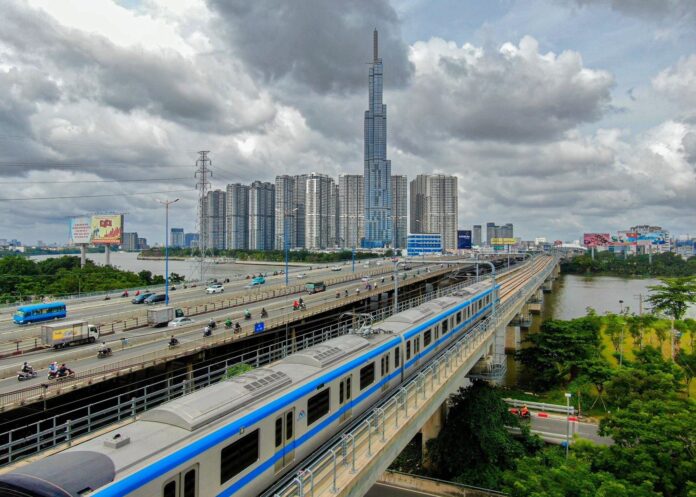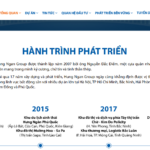Restructuring the Metro Network
On May 30, the Steering Committee for the Development of Ho Chi Minh City’s Urban Railway System issued Directive No. 01-TB/BCD, providing important instructions. By June 9, the Chairman of the Ho Chi Minh City People’s Committee had offered specific guidance on implementing the key contents, urging relevant departments to coordinate and take immediate action. Notably, the new orientation emphasizes the comprehensive adjustment of metro planning to align with the context of administrative mergers and urban development over the next 30 years.
The Department of Construction is assigned to lead and collaborate with other departments to thoroughly review the current urban railway network. This review is not merely technical but also aims to incorporate new development models in case of expanded administrative boundaries, including the integration of Binh Duong and Ba Ria-Vung Tau provinces.
The basis for this adjustment stems from various strategic master plans up to 2030 and vision up to 2050, including the overall planning of Ho Chi Minh City until 2040 (vision 2060). The metro network will be integrated with infrastructure and underground space planning, striving for a modern, multi-modal, and integrated transportation system.
Streamlining Investment Procedures
One notable aspect is the directive to minimize the time required for investment procedures for metro projects, effectively integrating them with other modes of transportation such as buses, roads, and waterways. This approach not only accelerates progress but also reduces social costs and creates economic spillover effects.
BOX OF NOTEWORTHY INFORMATION:
📌 2028 Target: Essentially complete land clearance for metro projects by 2028.
📌 Long-term Vision: Adjust metro planning until 2040, with a vision towards 2060.
📌 Expanded Territory: Orienting towards the integration of Binh Duong and Ba Ria-Vung Tau into the urban space.
📌 Special Mechanism: Flexibly applying Resolution 188/2025/QH15.
📌 Investment Capital: Diversifying sources, including PPP, non-budgetary funds, dedicated funds, and other legal sources.
The City People’s Committee also mandates the formulation of a comprehensive and flexible implementation plan, utilizing the special mechanism stipulated in Resolution 188/2025/QH15 to balance the interests of the State, investors, and society. Notably, policies within the City’s authority will be reviewed and finalized for timely issuance by the City People’s Council.
Regarding financial resources, the Department of Finance is tasked with formulating an investment capital mobilization scheme for metro development, guided by Conclusion No. 49-KL/TW of the Politburo. Contemplated mobilization methods include public-private partnerships (PPP), non-budgetary capital, dedicated funds, and other legal sources.
Concurrently, the City will devise a medium-term public investment plan for the periods 2026–2030 and 2031–2035, ensuring continuity and synchronization with the metro line development roadmap.
The Department of Home Affairs is assigned to study and propose a suitable metro management and operation model, which may involve private enterprises instead of solely relying on state units. Drawing on international experience and analyzing successful models will form the basis for formulating proposals to be submitted to the City People’s Committee and subsequently to the Steering Committee for approval.

Metro Line No. 1: Ben Thanh – Suoi Tien
Land Clearance to be Completed by 2028
The Department of Agriculture and Rural Development is entrusted with establishing an empowered organization to efficiently carry out compensation, support, and resettlement tasks. Given Ho Chi Minh City’s two-tier government model without district-level administration, the requirement is to clearly assign tasks according to the “6 Clears” principle: clear tasks, clear implementation, clear time frame, clear responsibilities, clear products, and clear authority.
The emphasized goal is to complete the handover of cleared land for metro projects by 2028, ensuring timely implementation. Additionally, the City requires full transparency in the process, offering reasonable compensation packages to affected individuals to garner social consensus.
The Great Divide: Exploring the Rising Prices and Polarizing Supply in Ho Chi Minh City and Binh Duong’s Apartment Markets in Q2.
In the first two months of Q2 2025, the residential real estate market, particularly the apartment sector in Ho Chi Minh City and neighboring provinces such as Binh Duong, witnessed a resurgence in activity and a new round of price adjustments.
“Developer of Hung Ngan Garden Requests Renewal of Waste Discharge Permit”
On May 9, 2025, the Department of Agriculture and Environment of Ho Chi Minh City released a proposal to grant an environmental permit to a high-rise residential and commercial complex project in Tan Chanh Hiep Ward, District 12 (Hung Ngan Garden). The project, led by Nha Hung Ngan Joint Stock Company, seeks to obtain a permit to discharge wastewater into the urban drainage system, with a maximum capacity of 600 cubic meters per day and an average of 270 cubic meters daily.
Where will Vung Tau feature on the development map in the race to become a megacity?
Nestled in the southeastern region of Ho Chi Minh City, Ba Ria – Vung Tau has emerged as a pivotal link in the transnational development corridor. This dynamic province connects the vibrant Southwest region, the bustling metropolis of Ho Chi Minh City, the thriving industrial hub of Dong Nai, and the picturesque Binh Thuan to the ASEAN countries through its well-developed seaports and the coastal economic corridor.
The Privé: The Ultimate Choice for Thu Thiem’s Elite
As Thu Thiem solidifies its position as Vietnam’s international financial hub, it attracts not only high-quality capital from across the globe but also becomes a magnet for the financial elite – the masterminds behind large corporations, institutions, and investment funds.





















